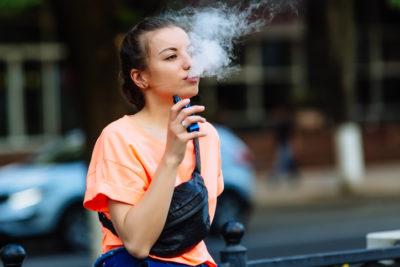How Teen Vaping Epidemic May Be Gateway to Scarier Drug Addictions
“Today, I am officially declaring e-cigarette use among youth an epidemic in the United States,” the U.S. Surgeon General, Dr. Jerome Adams, tweeted on Tuesday, December 18. He was responding to a string of reports in recent days and months regarding a shocking rise in rates of teen vaping.
The most recent report came in the form of survey findings released by the National Institutes of Health just this week. There it was reported that nearly 40 percent of seniors in 2018 had tried vaping, up from 28 percent in 2017. (In the annual “Monitoring the Future” survey, the researchers interviewed a nationally representative sample of eighth, 10th and 12th graders in schools nationwide.)
This week’s findings came on the heels of an earlier report by the Centers for Disease Control (CDC) that, released in November, documented a 78 percent increase in vaping among high schoolers.
As a further perspective, the CDC report stated, “Among high school students, current e-cigarette use increased from 1.5 percent in 2011 to 20.8 percent in 2018.”
Accompanying this shocking rise in teen vaping: a noticeable increase in the perceived availability of vaping devices, according to the NIH survey, with nearly half of eighth graders and roughly two-thirds of tenth graders reporting that the devices are “fairly easy” or “very easy” to acquire.
How Nicotine Is a Gateway to Other Addictive Drugs
What makes the exaggerated upward trend in teen vaping so troubling, and, in the words of the Surgeon General, “a significant public health threat”? Most e-cigarettes deliver nicotine— and in sometimes big amounts. Just how much? “A typical Juul cartridge, or ‘pod,’ contains about as much nicotine as a pack of 20 regular cigarettes,” Dr. Adams said in his official statement.
Problematically, too, many teens mistakenly think they are only vaping non-nicotine “flavorings.” In the NIH survey, the percent of seniors who said they vaped “just flavoring” in the past year increased to 25.7 percent (from 20.6 percent). Yet, as a summary of the survey findings on the NIH’s website pointed out, the most popular vaping devices do not have nicotine-free options, and even those that suggest that they do in their labeling may be providing inaccurate information.
But nicotine is highly addictive— and widely considered a “gateway drug,” meaning it can prompt its users to try stronger addictive drugs like marijuana and cocaine. (In fact, the latest survey results also revealed that more 12th graders are using e-cigarettes to vape marijuana.)
The Link Between Vaping and Other Addictions
Many people have said that vaping has helped them kick their smoking habit, or at least significantly reduce their need for cigarettes. For teens who have never smoked before, however, vaping may produce the opposite effect, leading them to take up smoking for the first time and/or explore other forms of recreational drug use. In this sense, e-cigarettes can be a gateway to scarier drugs and addictions.
That was, in fact, the conclusion of a 2014 study by the New England Journal of Medicine, which called e-cigarettes a “gateway drug” for both nicotine addiction and other addictive drugs. In making their case, the authors of the study pointed to previous research that found that nicotine can lead to marijuana and cocaine use. For example, in previous research summarized by the Partnership for Drug-Free Kids, the study authors found that nicotine significantly enhanced the effects of cocaine, and that most cocaine users were also smokers when they began using cocaine. Equally alarmingly, cocaine users who started cocaine after smoking cigarettes exhibited the highest rates of dependence.
The researchers also argued that e-cigarettes are only broadening the number of non-smoking teens who are now using nicotine, thereby increasing the gateway through which more people are likely to move on to harder substances.
The takeaway: that a battery-powered liquid nicotine vaporizer that is one person’s way to kick cigarettes may be another person’s steppingstone to scarier addictions.
Are you worried that your child’s vaping is masking a more severe addiction problem? Get help from professionals.


